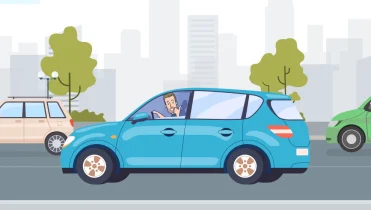- Home
- Personal Finance
- Guide
- What is used car underinsurance and how do you avoid it?
A guide to underinsurance for used cars
Own a secondhand car or considering buying one? With used car prices booming, you could end up being insured for less than the amount your vehicle is worth.
Here’s how to make sure your car insurance covers the true value of your vehicle.
Key Points
Underinsurance means your car insurance policy doesn’t cover the full value of your vehicle.
With used car prices booming, underinsurance has the potential to be a big issue.
If you’re underinsured, you could be left with hundreds or even thousands of dollars in out-of-pocket expenses if you need to make a claim.
Car insurance should give you peace of mind that you won’t be hit with a big bill in the event of an accident, damage or theft.
But the reality is that even if you’re insured, you might not be covered for the true value of your car.
This is especially true for used cars, which have been skyrocketing in price since the start of the pandemic.
Car underinsurance could leave you with hundreds or even thousands of dollars in out-of-pocket expenses if you need to make a claim – so it’s definitely worth keeping an eye out for.
Getting informed is a good first step.
By choosing the right level of car insurance, you can avoid being underinsured in case you’re ever in an accident.
What is underinsurance in car insurance?
Underinsurance is when you don’t have enough insurance to cover all the necessary costs if you need to make a claim.
In other words, if your insurance policy doesn’t cover enough to pay for everything it’s supposed to, you’re considered underinsured.
When it comes to car insurance for used vehicles, underinsurance means your insurance policy doesn’t cover the full value of your car.
For example, if you paid $30,000 for a used car but your car insurance policy covered you for an agreed or market value of $20,000, you would be underinsured by $10,000.
This means if your car was written off or stolen, you’d need to come up with the $10,000 yourself to pay for a like-for-like replacement.
Why is underinsurance an issue?
Right now the used car market is in overdrive.
Cars, like many other goods and services, are being impacted by global supply chain issues caused by the pandemic. The biggest ones affecting the car market are manufacturing plant shutdowns and a shortage of semiconductor chips needed to make new cars.
With fewer new cars available to buy, demand for secondhand cars is on the rise – and so are used car prices.
July 2022 figures show that secondhand car prices are 14.2% higher than they were at the same time last year, continuing an upward trend since the start of the pandemic.
Prices may be high, but it doesn’t mean insurers have caught up.
This means if the value of your car has risen since you took out your insurance policy, you could be underinsured.
Likewise, if you’re considering buying a used car, it’s a good idea to make sure you’re insured for the actual value of your car before you drive off the lot.
Should I increase car insurance cover on my used car?
This depends on the type of car insurance you have and the current value of your car.
If you only have CTP insurance or third party property insurance, damage to your own car isn’t covered so its value isn’t relevant to your policy.
The value of your car is something to consider if you have comprehensive car insurance, which generally covers repair and replacement costs for your own vehicle.
When you take out a comprehensive car insurance policy, your insurer sets the value they are covering your car for.
This could be an amount they determine to be the market value of the car (what it would sell for at that time), or an ‘agreed value’ both you and your insurer accept.
But be aware that at the time of writing, used cars are actually rising in value. This means you could be underinsured if you select market value.
Either way, if your insurance policy doesn’t accurately reflect the value of your used car, you could be underinsured.
What can I do if my car is underinsured?
If you have an existing insurance policy on a used car, it’s worth checking the covered value and getting in touch with your insurer if you think the valuation needs to change.
Keep in mind changing your car’s value could bump up your premium, meaning you might be able to get a better deal by switching to a new policy.
Comparing car insurance can help you get a handle on your options and find a policy that offers the best value for money in your situation.
Compare & SaveWhat type of insurance do I need for a secondhand car?
No matter what type of car you own in Australia, as a minimum you need to have Compulsory Third Party (CTP) insurance, which covers compensation payments for people injured or killed in an accident.
On top of that, there are three voluntary types of car insurance:
Third party property damage – covers damage you cause to someone else’s car or property.
Third party fire and theft – covers damage you cause to someone else’s car or property, as well as fire damage and theft to your car.
Comprehensive insurance – covers your vehicle in the event of accidents, theft, fire and weather damage, as well as damage to other vehicles and property.
Deciding which type of car insurance you need all depends on your situation.
If you want affordable car insurance that offers a bit more coverage than your CTP green slip, third party property damage cover or third party fire and theft cover could be a good choice.
That said, if your secondhand car is worth more than what you’d pay for insurance each year, you might want to consider going a step up to comprehensive car insurance. Your lender might also require you to have comprehensive cover if you have a car loan.
How do I find the best insurance for my used car?
If you’re considering buying a used car, keep an eye on the ‘sum insured’ when looking into car insurance policies so you know where you stand.
Already have an insured secondhand car? It’s worth checking the sum insured on your policy and getting in touch with your insurer if you think the valuation needs to change. Keep in mind that increasing your sum insured will typically increase your premium as well.
No matter what your situation looks like, comparing policies from different insurers makes it easier to know if you’re getting a good deal.
Compare Club can help you make sure your car is insured for the amount it’s worth.
With Compare Club, you can also see essential info and get car insurance options in just a few minutes.
Click the button below to get started.
GET A QUICK QUOTEThis guide is opinion only and should not be taken as financial advice. Check with a financial professional before making any decisions.
GENERAL ADVICE WARNING: General Advice is advice that has been prepared without considering your current objectives, financial situation or needs. Therefore, before acting on this advice, you should consider the appropriateness of the advice having regard to those objectives, situation or needs.
If the advice provided relates to the acquisition or possible acquisition of a new insurance policy you should consider the insurers PDS prior to making the decision to purchase their product. Information regarding the income we have been paid by the insurer for this transaction is available upon request.
Paul Coughran is the General Manager of Emerging Verticals at Compare Club. Paul has over 20 years of experience across a wide range of industries including Banking and Finance, Telecommunications and Energy. Paul leads a team of trusted experts dedicated to helping individuals make informed decisions about their insurance and utilities needs.

Meet our energy expert, Paul Coughran
Paul's top energy tips
- 1
Australia’s top three energy companies still hold 64% of the total Australian market, even though competition was deregulated in 2017.
- 2
If you don't shop around for energy providers, you’re probably leaving your savings on the table by failing to compare better value options.
- 3
Most energy providers offer discounted rates for new customers, which is a strong incentive to switch.
- 4
There should be no interruption when you switch energy providers. You'll need to pay a new company for your energy, but there won't be a disruption to your power supply.

